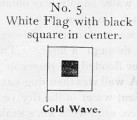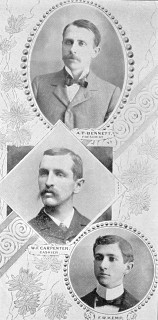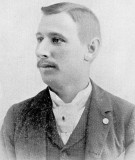
Peter Stephany

When the decision of the department was known, the people
became indignant and determined that a more vigorous effort should be made. A lengthy
petition was written and signed by every voter who could be found in the town and a large
number of farmers who made this their trading post.
Their petition was then forwarded to our
congressman, Mr. Carpenter, to be used by him in urging their request. Soon after this the
good tidings came that Manning was soon to have a post office.
The appointment of a post
toaster came to Seth Smith. After a weeks delay Mr. Smith received his commission lion but
no supplies, and no route had been designated. After another weeks delay the route was laid
direct from Carroll to Manning, and a man was hired and sworn to carry the mail, as the train
running on the Iowa South Western did not carry mail. Still no key was to be had, and no
supplies. Finally these came in part, and then it was discovered that a link was still wanting
in the route.
No one was ready to carry the pouch between the Carroll office and the Carroll station. All of this time the people of Manning stood ready to do anything reasonable or unreasonable to have their mail carried. They expected to pay the salary of the carrier from the office in Carroll to the depot in Manning but, for some unaccountable reason, were not permitted to do so.
Another act which aroused the indignation of the people, is
described in the Monitor as follows "And now, while we waited-waited and wondered,
wondered why the work did not begin -- comes upon the board some mysterious, mystified,
mucklehead, who superintends the route agencies and orders our mail matter carried to
West Side, a little town over in Crawford County with which we have no direct
communication whatever, and which sends out a
semi-weekly mail that runs three miles west of us there the snail for six or eight hundred
people is dropped twice a week while we have a daily train into town.
All of this time the people of Manning were paying a Mail carrier twenty-nine dollars
a month to carry the mail from Carroll.
The people of Manning and the Post Office officials continued thus at swords points till in January of 1882. After the Iowa a South Western had established a daily train service between Carroll and Kirkman, the town was able to abolish the snail carrier service and have their mail delivered daily by rail.
The post office fixtures were purchased by Mr. Smith of Mr. Hastings, who was at this time post master at Carroll. The four hundred call boxes and twenty lock drawers were soon all rented out, and the post office was then run in its full capacity.
As stated before, Seth Smith was the first post master. He served till September 30, 1885, when his resignation took effect. He was succeeded by E. M. Funk who took charge of the office October 1, 1885.
The most interesting feature of Mr. Funk's administration, occurred soon after his
ascention to office. Up to December 1885, the post office had been kept in a building
located in Block 6. December 20, between 4 A. M. and 7 P. M., Mr. Funk moved the post
office and fixtures to a building, in a block south, owned by him. When the business men
of the block in which the post office had been located came to get their mail the following;
morning, much excitement ensued, and strong adjectives, gutteral and other wise, were
used.
It surprised every body except those who had assisted in the removal. Even the
deputy post master was not aware of it till he came down to open the office in the morning.
Mr. Funk was succeeded in office by W. F. Carpenter who took charge of the same in
February of 1889. He resigned in the summer of 1892; being suceeded by E. L. Ives who
completed the term and was re-appointed for the ensuing term which expired in February of 1896.
Peter Stephany is the present incumbent, having succeeded E.L. Ives. He is assisted by his sister, Katheryn Stephany, who makes an able and accomodating deputy.

United States Weather Signal Service.
Mr. Stephany, constantly having the good of the community at heart, spent much time and
considerable money in getting a government signal station located at Manning; the
reports came from Neola, the distributing center for this district. This, however, was not
satisfactory as the reports came by mail and did not arrive here till in the afternoon.
After considerable trouble, Mr. Stephany succeeded in having Manning made the distributing
center, by which, receiving the forecasts by telegram early in the morning and mailing
them to the other stations in the district, the majority of the stations received their
forecasts nearly six hours earlier. For these services the community as well as he
surrounding towns ought to be very thankful as Mr. Stephany receives no remuneration
for his services, whatever. The station was opened in February of 1898.
Here Telegraphic messages are received daily "except Sunday" from the Department at Chicago, after which they are communicated from here by mail to the following towns: Aspinwall, Astor, Audubon, Arion, Botna, Buck Grove, Charter Oak. Des Moines, Defiance, Earling, Gray, Glenellen, Grant Center, Hornick, Irwin, Kirkman, Kenwood, Luton, Mapleton, Panama, Persia, Portsmouth, Rodney, Ross, Ute, Yorkshire. Some towns receive two forecasts, making a total of 31 Forecasts sent out each day.
The following illustration and explanation, will give the reader a knowledge of the intricate
workings of this bureau if displayed on the pole in front of the office.
No. 1 Clear or fair weather.
No. 2 Rain or Snow.
No. 3 Local Rain or Snow.
No. 4 Temperature Signal. When displayed above the Weather flag, rising
Temperature, when below, falling.
No. 5 Cold Wave
 |
 |
 |
 |
 |
If more than one kind of weather is predicted for the Period from 8 P. M. to 8 P. M., the
conditions first named in the forecasts will be represented by the uppermost weather flag
in a vertical hoist from which the signals are to be read.
All casts supposed to designate the weather for twenty-four hours from the time of
hoisting; except in case of sudden changes.

Manning Hose Company and Water Works,
Up till the organization of the Manning Hose Company, the only method of fighting fires
was with fire buckets and even then there was no system, not even a bucket brigade; but
each one could pitch in and do it all or stand on the street corner with his hands in his
pockets and whistle, or criticise the methods employed by thane who were assisting,
The growth of the town had increased to such an extent and the need of an organized fire
company had become so apparent, that May 15 1884, the first meeting was called for the
purpose of organizing a hose company.
An organization was perfected with the following
officers and membership: President, N. J. Smith; Vice President, J. M. Nettle; Foreman. F.
W. Arney; Assistant Foreman, W. P. Guild; Secretary, Neil McArthur; Treasurer, G. F.
Chapman; Trustees, E. C. Perry, Albert Lincoln Wright, C. S. Lawrence; Members, R. L. Zane J. B.
Henshaw, D. D. Clark, W. F. Carpenter, C. Johnson, E. Smith and F. Wilkins.
At this time the only water supply was the wells and cisterns, however was promise of a better water system as bids had been landed in for the institution of a tank system of water works The system was ready for operation by the autumn of 1884. The tower stands 30 feet high and supports a tank with a capacity of 50,000 gallons.
The water supply was obtained south of the tank, across the C. N. W. track, in close
proximity to the present pumping station. A reservoir was sunk near, and lower, than the
creek bed, and supplied from the creek through a filter.
This, however, proved unsatisfactory, as high water flooded the reservoir filling it with sediment and impure
water. A well was then dug east of the reservoir, but this failed to supply sufficient water
in the dry years of 1893-4. In 1894, nine three inch, driven sand wells were sunk and
connected with the pumping station. These have proven very satisfactory both for
quantity and purity of water.
Up till 1894, the water was forced to the tank by wind power, but after the sand wells were
sunk, the he power was changed to steam. Now, the water is forced from the sand wells to
the tank by a steam pump equal to a 25 horse power and has a pumping capacity of
11,000 gallons per hour.
There is over a mile of 6 and 4 inch mains, which renders it very
convenient to tap for private use and affords excellent fire protection; as these mains
connect with 14 double fire plugs to which can be attached the 1500 feet of hose, thus
carrying a powerful stream of water to almost any building in the town. There are three
hose carts for the reeling of the hose, and a hook and ladder truck, fully equipped with
ladders, buckets. and all such appliances as are necessary in the case of fire.
Referring back to the organization of the hose company, it was organized under the name;
After the organization of the Company to purchase a hosecart and hose was the next thing in order, as the completion of the water works was only a matter of a few months. The request for a hose cart was presented to the town council, and in less than a week the council reported that they had contracted for a hose cart of superior quality. A running team was then selected, consisting of the following members; Pole, Peter M. Loes, Frank Laird; Lead, Dwight Patton, Fred Miller and F. P. Guild, J. P. Arp alternates; Couplers, A. L. Wright, W. F. Carpenter; Reel-men, J. P. Arp, W. F. Arney; Captain, W. F. Carpenter; Rope-men, D. W. Sutherland, W. E. Guild, F. Laird, J. W. Morrow.

For the benefit of the team in practicing, they purchased in June of 1887, 300 feet of tournament hose, a half interest of which was purchased by the town which seemed to display a very liberal attitude. The hose was purchased for $150.00. There was also two speaking trumpets, a play pipe and a practicing coupling purchased at the same time. This placed the company in good condition for practice and effective results. The company applied for, and was admitted to membership of the Iowa Fireman's Association in the spring of this year.
THE SIOUX CITY TOURNAMENT this year was the most important
event in which the team ever took part. The team was composed of, J. W. Marrow, P. M.
Loes, James Hathaway, W. F. Carpenter, A. L. Wright, D. W. Patton, Frank Laird, William
Hathaway, E. M. Funk, Peter Murray, Frank Ferguson, L. M. Conkling, J. P. Arp, Charles
Coe, Frank Arney, Joseph Bemrose, Fred Miller and William Coe. The team's practice time
was 47 seconds for 300 yards on a slow track. At the tournament they entered in the "49
second class" and won third money.
In the "46 second class" they would have taken third
money had their hose not been tramped on by some parties who had no right, on the track.
In this race, they made a record of 39 seconds, the second best time made during the
tournament. This was the first state, tournament in which they had taken pant, and
consequently, they were not "onto the tricks" practiced by some of the professional
teams. After this year, the interest began to wane, and the team finally disbanded.
THE PRESENT HOSE AND FIRE COMPANY number, in all, twenty six members as follows: President, J. P. Arp; Secretary, W. B. Parrott; Treasurer, E. K. Johnson; Chief, William Wunrath; Asst. Chief, Fred Miller; Trustees, William Wehrman, Peter Stephany and C. J. Larson; Members, H. M. Free, Clinton Kenyon, George Shelldorf, John Grelck, John Frahm, Martin Brunnier, Julius Ruge, C. H. Reinholdt, John Schnoor, Herman Grau, Charles Schmidt, Edward Breckenridge, August Reimer, R. Wohlers, H. P. Hansen and D. W. Patton.
